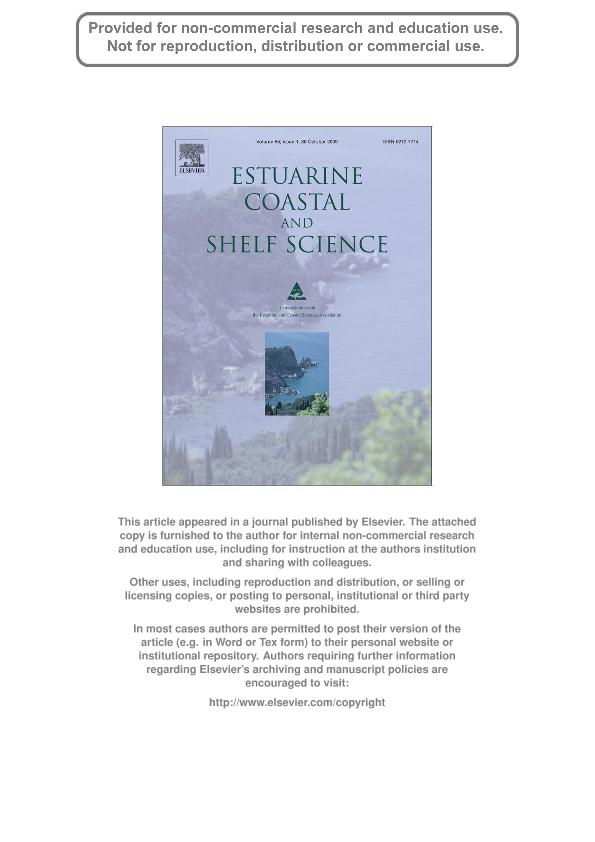Artículo
Spatial and temporal distribution of cadmium and copper in water and zooplankton in the Bahía Blanca estuary, Argentina
Fernandez Severini, Melisa Daiana ; Botté, Sandra Elizabeth
; Botté, Sandra Elizabeth ; Hoffmeyer, Monica Susana
; Hoffmeyer, Monica Susana ; Marcovecchio, Jorge Eduardo
; Marcovecchio, Jorge Eduardo
 ; Botté, Sandra Elizabeth
; Botté, Sandra Elizabeth ; Hoffmeyer, Monica Susana
; Hoffmeyer, Monica Susana ; Marcovecchio, Jorge Eduardo
; Marcovecchio, Jorge Eduardo
Fecha de publicación:
05/2009
Editorial:
Elsevier
Revista:
Estuarine, Coastal and Shelf Science
ISSN:
0272-7714
Idioma:
Inglés
Tipo de recurso:
Artículo publicado
Clasificación temática:
Resumen
Cadmium and copper in the dissolved and particulate phase and in zooplankton were determined in the Bahı ́ a Blanca estuary during six surveys from March to December 2005. Temperature, pH, salinity, dis- solved oxygen, suspended particulate matter, particulate organic matter and chlorophyll- a were also considered. Dissolved Cd was below the detection limit (0.2 m gL 1 ) for almost the entire study period whereas Cu concentrations (0.5–2.4 m gL 1 ) indicated a continuous dissolved Cu input. Particulate Cd concentrations ranged from below the detection limit ( < 0.01) to 28.6 m gg 1 d.w. while particulate Cu ranged from below the detection limit ( < 0.04) to 53.5 m gg 1 d.w. Cd in mesozooplankton ranged from below the detection limit ( < 0.01) to 37.4 m gg 1 d.w. Some of the Cd levels were higher than those reported for other aquatic ecosystems. Cu in the mesozooplankton ranged from 1.3 to 89.3 m gg 1 d.w., values which were within the reported values or higher than other studies. The log of the partition coefficients (log ( K d )) of Cd was 0.04, while log ( K d ) for Cu ranged from 0.39 to 2.79. These values were lower than both those calculated for other estuaries and the typical coefficients for marine environments. The log of the bioconcentration factor (log BCF) of Cd was 1.78, indicating that Cd concentration was higher in the zooplankton than in the dissolved phase. Log BCF of Cu ranged from 1.15 to 3. The logs of the biomagnification factors (log BMF) of Cd were low, with a range between 3.45 and 2.21 and those for Cu ranged from 0.1 to 3.35. Positive values indicate biomagnification while negative values indicate biodiminution. In general, no significant dissolved Cd concentration appeared to be present in the Bahı ́ a Blanca estuary and Cu values did not indicate a critical environmental status. The particulate phase seemed to be the major carrier for Cd and Cu and TPCu values were within the normal values for an anthropogenically stressed estuary but not for a strongly polluted system. This fraction was the most important metal source for the mesozooplankton. Moreover, the highest metal concentrations were in the mesozooplankton since most of the bioconcentration and biomagnification factors were positive, especially for Cu.
Palabras clave:
Cadmiun
,
Copper
,
Water
,
Zooplankton
Archivos asociados
Licencia
Identificadores
Colecciones
Articulos(IADO)
Articulos de INST.ARG.DE OCEANOGRAFIA (I)
Articulos de INST.ARG.DE OCEANOGRAFIA (I)
Citación
Fernandez Severini, Melisa Daiana; Botté, Sandra Elizabeth; Hoffmeyer, Monica Susana; Marcovecchio, Jorge Eduardo; Spatial and temporal distribution of cadmium and copper in water and zooplankton in the Bahía Blanca estuary, Argentina; Elsevier; Estuarine, Coastal and Shelf Science; 85; 1; 5-2009; 57-66
Compartir
Altmétricas



